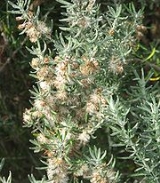
Olearia axillaris
Encyclopedia
Olearia axillaris is a shrub of the Asteraceae
family, found in coastal areas of Australia. Commonly known as the Coastal Daisybush, it was one of the first edible plants to be discovered by Europeans.
The leaves are small and many, in whorled arrangement at the stem, and covered in fine white hairs which contribute to the silvery colour of the shrub. These are about 12 mm long and may be 1 – 3 mm across, linear in shape, having a margin rolled toward the reverse, and are fragrant when crushed. Older leaves may lose the woolly covering and become smooth and green.
The yellow florets are supported by white bracts at the flowerhead. The fruit produced are achenes, 1.5 – 2 mm long, the pappus
are bristles twice this length; this assists in the dispersal of the seeds by wind.
, South Australia
, Victoria
, New South Wales
and Tasmania
. The plant is found in the vegetation claiming sand dunes, and also appears on limestone and rocky slopes along the coastline. While the species is restricted to the coast in other states, West Australian specimens have been found in similar habitat at inland locations.
and William Dampier
, ventured to eat this plant - its aromatic quality inspiring its use as a herb. Vlamingh's crew made use of leaves collected, when anchored at Rottnest Island
, adding it to their meagre onboard diet.
Asteraceae
The Asteraceae or Compositae , is an exceedingly large and widespread family of vascular plants. The group has more than 22,750 currently accepted species, spread across 1620 genera and 12 subfamilies...
family, found in coastal areas of Australia. Commonly known as the Coastal Daisybush, it was one of the first edible plants to be discovered by Europeans.
Description
The species is an erect shrubby herb growing to 2 metres high, many branched, densely covered with small leaves, and has a silvery green appearance. It is readily identifiable, by its height, when amongst the vegetation venturing onto dune systems - pioneer plants. It is tolerant of strong winds, salt, and poor soils.The leaves are small and many, in whorled arrangement at the stem, and covered in fine white hairs which contribute to the silvery colour of the shrub. These are about 12 mm long and may be 1 – 3 mm across, linear in shape, having a margin rolled toward the reverse, and are fragrant when crushed. Older leaves may lose the woolly covering and become smooth and green.
The yellow florets are supported by white bracts at the flowerhead. The fruit produced are achenes, 1.5 – 2 mm long, the pappus
Pappus (flower structure)
The pappus is the modified calyx, the part of an individual disk, ray or ligule floret surrounding the base of the corolla, in flower heads of the plant family Asteraceae. The pappus may be composed of bristles , awns, scales, or may be absent. In some species, the pappus is too small to see...
are bristles twice this length; this assists in the dispersal of the seeds by wind.
Distribution
The species occurs in southern coastal regions of Western AustraliaWestern Australia
Western Australia is a state of Australia, occupying the entire western third of the Australian continent. It is bounded by the Indian Ocean to the north and west, the Great Australian Bight and Indian Ocean to the south, the Northern Territory to the north-east and South Australia to the south-east...
, South Australia
South Australia
South Australia is a state of Australia in the southern central part of the country. It covers some of the most arid parts of the continent; with a total land area of , it is the fourth largest of Australia's six states and two territories.South Australia shares borders with all of the mainland...
, Victoria
Victoria (Australia)
Victoria is the second most populous state in Australia. Geographically the smallest mainland state, Victoria is bordered by New South Wales, South Australia, and Tasmania on Boundary Islet to the north, west and south respectively....
, New South Wales
New South Wales
New South Wales is a state of :Australia, located in the east of the country. It is bordered by Queensland, Victoria and South Australia to the north, south and west respectively. To the east, the state is bordered by the Tasman Sea, which forms part of the Pacific Ocean. New South Wales...
and Tasmania
Tasmania
Tasmania is an Australian island and state. It is south of the continent, separated by Bass Strait. The state includes the island of Tasmania—the 26th largest island in the world—and the surrounding islands. The state has a population of 507,626 , of whom almost half reside in the greater Hobart...
. The plant is found in the vegetation claiming sand dunes, and also appears on limestone and rocky slopes along the coastline. While the species is restricted to the coast in other states, West Australian specimens have been found in similar habitat at inland locations.
History
Two early visitors to the coast and islands of Western Australia, Willem de VlaminghWillem de Vlamingh
Willem Hesselsz de Vlamingh was a Dutch sea-captain who explored the central west coast of Australia in the late 17th century.- Vlamingh and the VOC :...
and William Dampier
William Dampier
William Dampier was an English buccaneer, sea captain, author and scientific observer...
, ventured to eat this plant - its aromatic quality inspiring its use as a herb. Vlamingh's crew made use of leaves collected, when anchored at Rottnest Island
Rottnest Island
Rottnest Island is located off the coast of Western Australia, near Fremantle. It is called Wadjemup by the Noongar people, meaning "place across the water". The island is long, and at its widest point with a total land area of . It is classified as an A Class Reserve and is managed by the...
, adding it to their meagre onboard diet.

